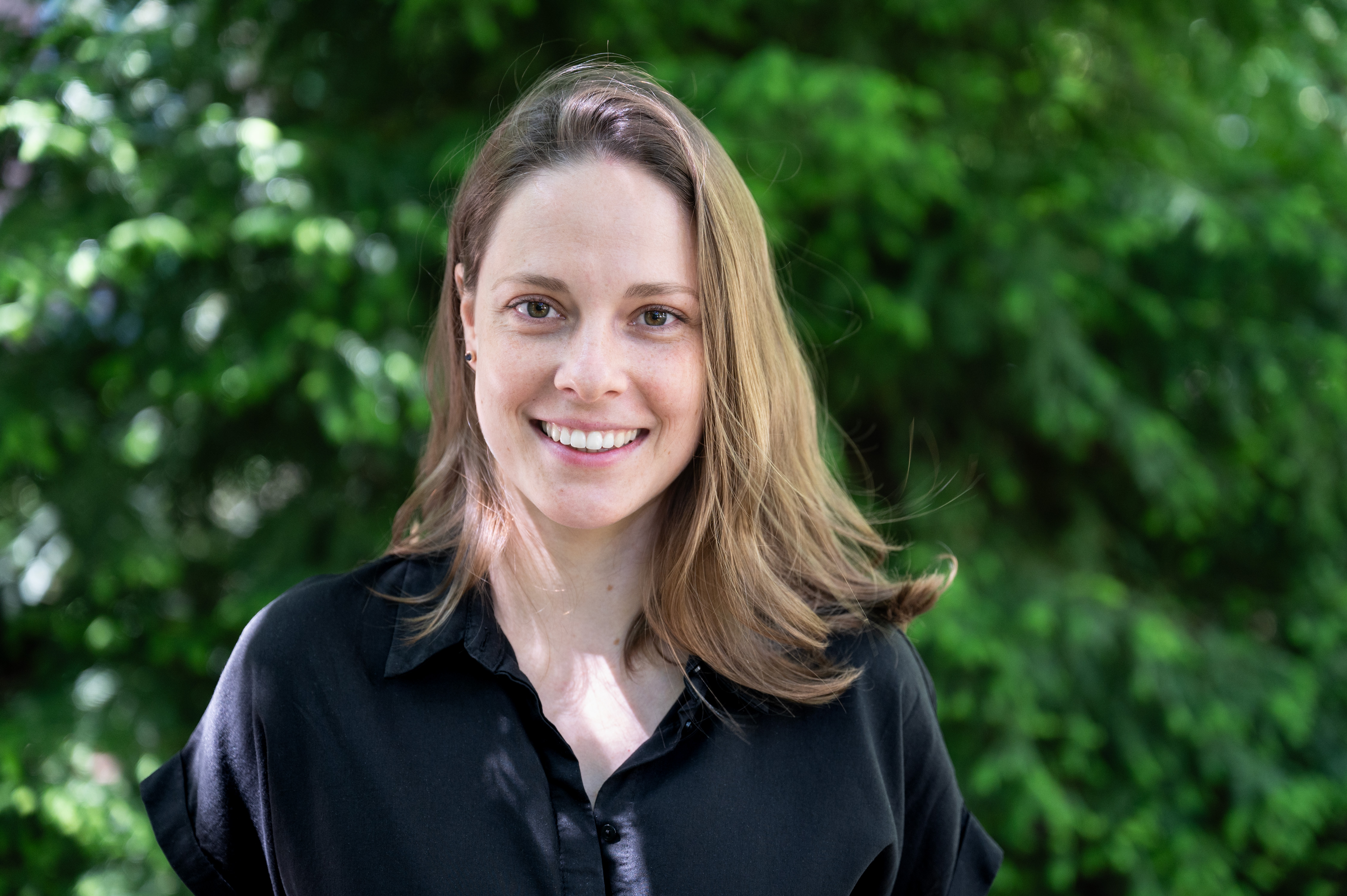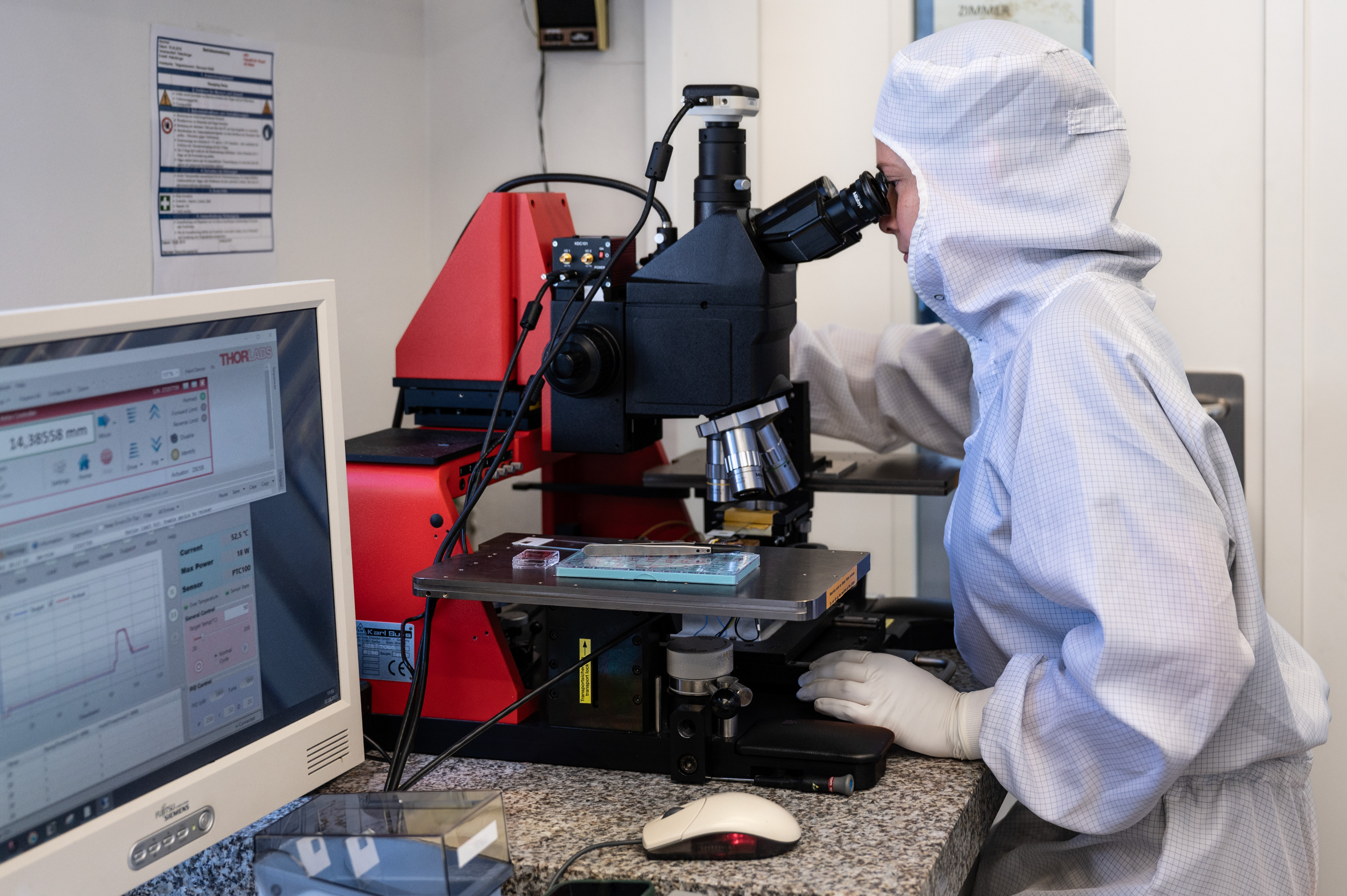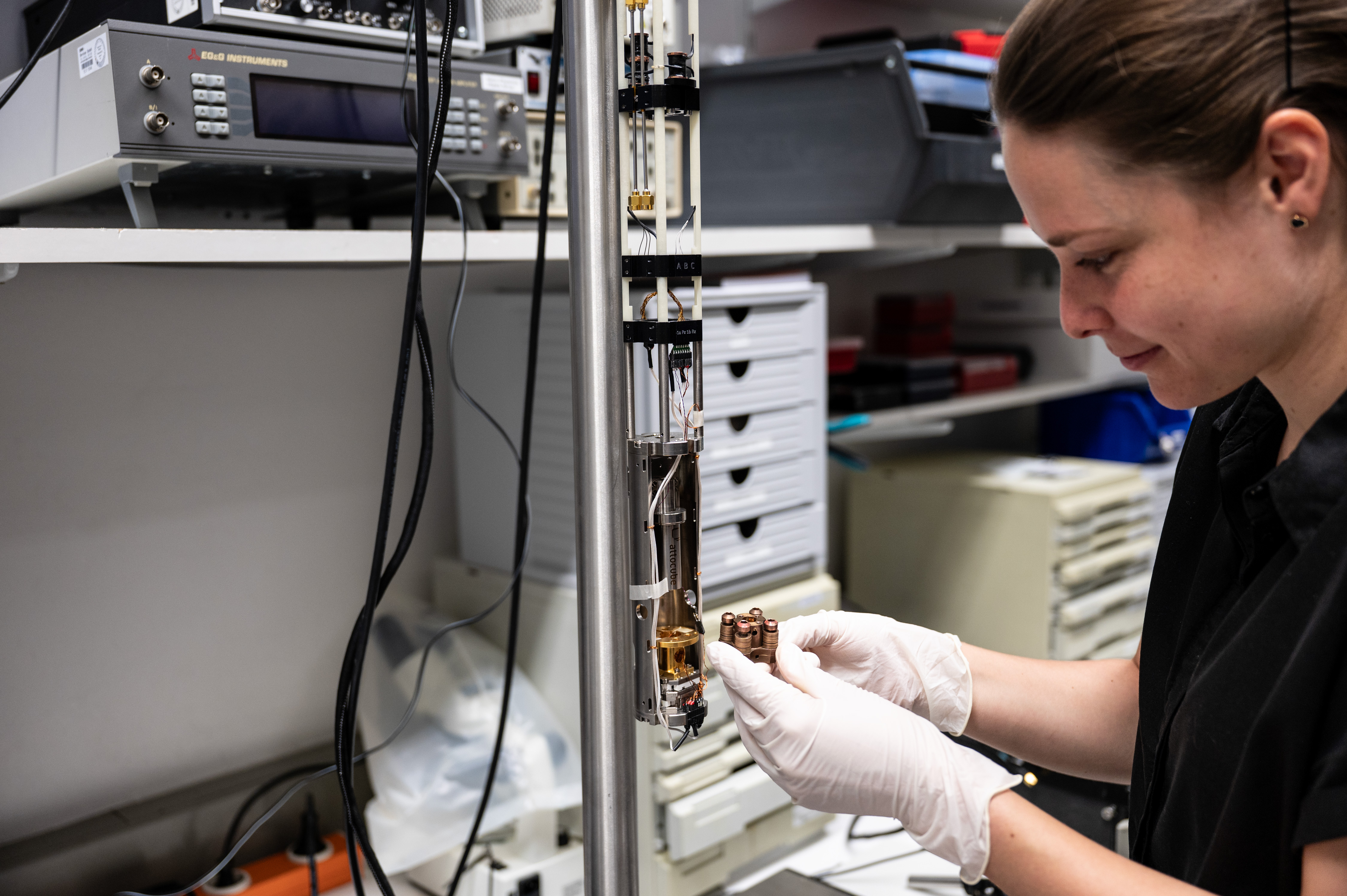"This offers a whole new kind of physics"
Atom by atom to new materials
Reaching the goal step by step with patience and diligence. These qualities, along with a large dose of perseverance, have already brought Anna Rupp several successes, both in sports and in her research on ultrathin nanomaterials.
By Maria Poxleitner
"In the beginning, things break all the time." Anna Rupp shrugs and her expression shows that this is annoying, but somehow normal. The 25-year-old physicist is talking about "stamping". That's what Anna and her colleagues call it when they superimpose very thin layers of different materials in the clean room. In this case, "very thin" means that a layer is only "one atom thick".
Anna studies these materials, which are so thin they are called two-dimensional or 2D materials. Artificially produced crystals in which several single layers, called monolayers, are stacked on top of each other to form a heterostructure – similar to the Bavarian "Prinzregententorte", which is not made of a homogeneous mass of dough, but of different thin layers. Depending on which elements make up the individual monolayers, how many layers there are, and whether they are stacked parallel or twisted to each other, the result are materials with very different properties that are not usually found in naturally occurring crystals. Some materials suddenly become superconducting, others exhibit magnetic or special electronic behavior. Ultimately, the goal is always to adapt the material properties for application requirements, explains the MQV doctoral fellow. Applications could be, for example, new or better electronic components or single-photon sources for use in quantum communication and other quantum technologies.
The range of possible applications is broad, "but first, we need to understand our materials," admits the doctoral student. In the diverse "zoo" of 2D materials, her research group has focused on double layers of molybdenum and selenium or tungsten and selenium. Anna's specialty are double layers, where the two monolayers are twisted against each other, leading to novel quantum phenomena. In these materials, free-moving electrons are slowed down, so to speak. "As a result, the electrons sense each other and behave collectively. And this behavior is very exciting and offers a whole new kind of physics," enthuses the young physicist, and it's easy to see that discovering and understanding these exciting effects is what drives her in her research. But before anything can be discovered, the material samples have to be made. Neither Anna nor the other doctoral and master's students are exempt from this task.
Working with materials that are only a few atoms thick requires a steady hand
The samples are prepared using a kind of stamp that has to be carefully moved up and down in order to pick up the different monolayers in the desired order. This requires the finest of adjustments – or simply a lot of practice. One wrong adjustment or movement and the ultrathin layers break. The stamping procedure is done in a clean room because not a single particle, no matter how small, should get between the individual layers. Therefore, you can hear the noise of the filter systems all the time. Taking off her street shoes, putting on her cleanroom suit and shoes, tucking her brown hair under her cap, and putting on gloves – this was Anna's morning ritual during her master's thesis. "The cleanroom was my second home at that time," laughs the physicist.

Anna Rupp, 25
Position
Institute
LMU – Chair of Experimental Physics: Nanophotonics Group
Degree
Physics
Anna studies materials, which are so thin they are called two-dimensional. They are made by stacking different layers, which consist of a single layer of atoms, vertically on top of each other. In the artificial crystals, exciting physical effects can be observed, which are promising for a plethora of applications. Some of these effects only occur when the materials are exposed to extreme conditions. For this reason, in her Ph.D. Anna is studying the 2D materials under extremely high pressure.

However, preparing lots of samples was more of a means to an end. The actual goal was to develop an imaging technique that could reveal the fine geometric patterns that form between the double layers. These so-called moiré patterns are what influence the properties of the electrons and lead to the exciting collective phenomena, Anna explains. "We can also see moiré patterns in everyday life. If we put two very similar patterns on top of each other, or two identical layers but slightly rotated against each other, we suddenly see a third pattern. And our materials behave similarly." Unlike the moiré effect seen in everyday life, however, this is not a purely optical effect. The atoms of the double layer also rearrange themselves to reach the most energetically favorable state. This so-called reconstruction results in very fine spatial patterns. Anna's materials produce perfect triangular patterns with triangles smaller than 100 nanometers – but perfect only in theory.
Finding the perfect recipe
The measurements on the samples did not confirm this. "The spectra were very chaotic," tells the physicist. Obviously, an ideal regular pattern does not emerge as originally thought. "But we didn't know, we couldn't just look at it." The challenge: "Looking at it" requires a high-resolution imaging technique. However, the scanning electron microscopy method that was planned to be used was initially not suitable for this purpose. When used conventionally, the imaging information comes from a region of a hundred nanometer thickness, Anna explains. "But if we want to visualize the moiré pattern, the imaging information has to come from our double layer, which is less than a nanometer thin." So for her master's thesis, she optimized the scanning electron microscopy technique for the 2D materials her group studies. For that, she had to find the optimal parameters, using, for example, simulations to determine the optimal angle of tilt and rotation of the sample relative to the electron beam, as these affect image contrast. It was a matter of finding the perfect recipe, Anna compares. "I think I made at least 50 samples before I saw something and until I understood it".
Her "perfect recipe" was a big advance for the research community and led – together with some other important results – to a publication. Although there are other methods that can resolve such fine surface structures, they are not always suitable, the doctoral student adds, because they, for example, affect the moiré pattern, make subsequent optical analysis impossible, or simply take too long. For her own research group, Anna's results also meant the possibility of disproving the prevailing notion of ideal, regular patterns through images, which is why her work was also an important contribution to a publication by Nature.
So all those long hours in the clean room were worth it. Fortunately, her apartment and the institute are only a few hundred meters apart. The young doctoral student really appreciates the short way to work. This saves time and allows Anna to spontaneously join her colleagues for a game of volleyball in the English Garden or an after-work drink on the institute's roof terrace. Through the windows of her office, which Anna shares with six other students, one can look out onto the green Salinenhof. The midday sun shines into the large room with its high vaulted ceiling. The old and venerable building is in stark contrast to the laboratories with their experimental setups and the clean room with its expensive equipment. The fact that the latter is being renovated as part of the MQV project will also benefit Anna. "We'll be getting new, modern equipment that will allow for higher resolution, more precise analysis methods and more accurate stamping," she says happily.

Working in the lab and doing things hands-on
In her Ph.D., Anna will explore whether other exciting effects occur in 2D materials when exposed to extreme conditions. She will therefore be observing her samples under high pressure. Therefore, she has to set up a lot of new things: build and adjust the laser setup for spectroscopy, write the computer program to control everything, make new and more complicated samples. The fact that the tasks are so varied and different is what she really likes. Working in the lab and doing things hands-on was what excited her from the beginning. "I found some of the physics courses very dry. Always calculating and solving problem sheets. I wanted to see the application and work with the equipment," recalls the young doctoral student. She knew from the start that she wanted to became an experimental physicist.
Now, at the beginning of her Ph.D., Anna is mainly fiddling with the setup she will use to generate the high pressure to which she will expose her samples. At first glance, it is an inconspicuous metal housing, only a few centimeters in size. With a steady hand, Anna opens the "cell", as she calls the housing, and points to a very small diamond on which, barely visible, the tiny material-sample sits. There are actually two diamonds, she explains, one top and one bottom diamond. "With these diamond pressure cells pressures of over 300 giga-pascals can be achieved, which is actually the pressure in the Earth's core". For the time being, however, she will only go up to about 20 giga-pascals with her cell, Anna adds. Diamonds, the hardest material in the world, are one of the things needed to generate the high pressure. However, the pressure should not only be applied to the sample from above and below, but evenly from all sides. "That's why you need an additional medium that you enclose in the cell", continues the physicist. Anna learned about the method during a stay as a visiting scientist in Berkeley. There, salt was used as a pressure medium. Here in Munich, however, the doctoral student has to use a liquid, as the salt would destroy the samples. "It's much more difficult with a liquid. Sometimes you accidentally trap an air bubble, sometimes the liquid evaporates or you have a leak somewhere. I spent a month just practicing closing the cell without even having a sample in it. It's a bit annoying," Anna laughs, rolling her eyes.
But Anna is not one to give up easily. On the contrary, even in her free time she pursues challenges that require patience and perseverance. For example, when she practices doing a handstand from a backward roll during her freestyle acrobatics class. One of her greatest hobbies is certainly sailing. At the age of 17, she competed in the Youth World Championships – and won the World Championship title in her boat class. What she likes about sailing is that it challenges one both physically and mentally. "With your feet in the hiking straps and your upper body leaning over the boat edge to push against the wind, every muscle is used," describes Anna. At the same time, one must keep an eye on the coastline and how the wind and clouds are developing, she continues. Sailing is not as much a part of her everyday life as it was when she was in school, but she still pursues her hobby during her vacations. Besides freestyle acrobatics, she is currently trying high diving as an alternative for working days. "It's all about full body control, that's cool".
Anna feels very much at home in Munich and appreciates the research environment. In fact, she was also invited to go to Harvard with her professor from Berkeley. One can see that this was quite tempting for the young physicist. For her, however, there were many reasons to choose Munich. Not least of these was the MQV doctoral fellowship, for which she had already successfully competed against other applicants at that time. What she wishes for her Ph.D.? "That I finally understand my materials," says Anna with a laugh. As modest as this wish may sound, there is still a lot of exciting physics to be discovered and explored in nanomaterials.
Published 22 September 2023; Interview 02 June 2023